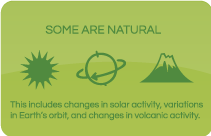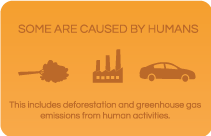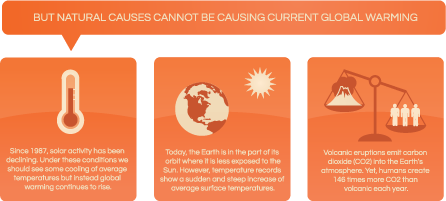Climate change is when the average long-term weather patterns of a region are altered for an extended period of time, typically decades or longer. Examples include shifts in wind patterns, the average temperature or the amount of precipitation. These changes can affect one region, many regions or the whole planet.
Climate changes are caused by changes in the total amount of energy that is kept within the Earth's atmosphere. This change in energy is then spread out around the globe mainly by ocean currents as well as wind and weather patterns to affect the climates of different regions.
What are the causes of climate change?
Natural processes such as volcanic eruptions, variations in Earth's orbit or changes in the sun's intensity are possible causes.
However, humans activities can also cause changes to the climate for example by creating greenhouse gases emissions or cutting down forests.
The Earth's climate has never been completely static and in the past the planet's climate has changed due to natural causes.
Global warming and the climate changes seen today are being caused by the increase of carbon dioxide (CO2) and other greenhouse gas emissions by humans.
Human activities like the burning of fossil fuels, industrial production, etc. increase greenhouse gas levels. This traps more heat in our atmosphere, which drives global warming and climate change.
So while CO2 and other greenhouse gases are naturally present in the atmosphere, emissions from human activities have greatly amplified the natural greenhouse effect. CO2 concentrations in the Earth's atmosphere has increased significantly since the beginning of the Industrial Revolution, and most especially in the past 50 years.
Computer models, ice core evidence as well as fossilized land and marine samples show that CO2 is at it's highest level in the last 3 million years and that CO2 concentrations have increased because of human activities like fossil fuel use and deforestation.
Human activities have caused the Earth's average temperature to increase by more than 0.75°C over the last 100 years. Scientists have tracked not only the changes in the temperature of the air and oceans, but other indicators such as the melting of the polar ice caps and the increase of world-wide sea levels.
The impact of these shifts have an impact on all life-forms on our planet including their sources of food and water. Current impacts that are already being observed are desertification, rising sea-levels as well as stronger extreme weather events like hurricanes and cyclones.
More info:
What is Climate Change? - Climate Action Network Canada
Basics: Climate Change - US EPA
Climate Change: Evidence - NASA
What is climate change? - BBC News



